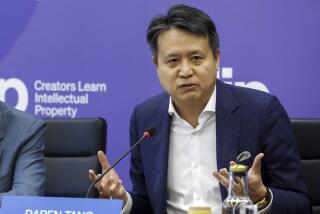Rising Tide of Foreign Patents Stirs Debate About U.S. Competitiveness
Mikhail Tsinberg’s workroom at Philips Laboratories near Ossining, N.Y., brims with the gear of the modern inventor: Television monitors tuned to test patterns stand on shelves, stacks of electronic equipment blink silently in corners, and bench drawers display labels for mysterious gizmos such as “logic analyzer probes parts.”
It’s a playground for the Soviet-born engineer, who in the past six years has won four U.S. patents in high-definition television under the aegis of Dutch-owned North American Philips Corp. But it’s also a vantage point from which he surveys U.S. technology. And these days, Tsinberg is starting to worry that the invention prowess of his adopted country is weakening.
He sees signs everywhere--from what he terms the “lousy” science and math education in this country to the closing of major research laboratories owing to corporate restructurings. He notes, too, that European- and Asian-born scientists are the majority at research labs where he has worked in the United States and that increasing numbers of U.S. patents are granted to Japanese companies.
“When Sputnik was launched, it captured headlines” and prompted a rapid U.S. response, the inventor said. “But with this slow decay process, there’s nothing to put in headlines. It’s hard to notice and very dangerous.”
Just One Voice
Tsinberg’s is just one voice in a growing debate about America’s technological competitiveness. Some analysts say America’s technology engine is sputtering while the engines of Japan, Korea and Western Europe are at full tilt. If current trends continue, analysts say, the nation will experience a technology deficit that could lead to more anemic manufacturing in certain industries and, ultimately, a decreased standard of living. America’s loss of dominance in consumer electronics and automobiles is the point of the wedge, the experts maintain.
Others say America is not lagging, that the country is pre-eminent in several cutting-edge fields such as biotechnology and computers. Rather, the world is simply catching up--a positive development.
At the center of the debate are statistics compiled by the federal Patent and Trademark Office in Arlington, Va. An increasing number of U.S. patents are being awarded to foreign residents and corporations.
In 1988, of the 77,925 patents issued (excluding grants for plants and designs), 48% were awarded to nonresidents. Japan received the most (16,158, or 21%), followed by West Germany (9%), the United Kingdom and France (3% each).
This invention snapshot contrasts sharply with the picture 25 years before, when 18.6% of U.S. patents were awarded to foreigners. Patent grants to foreigners will reach the 50% mark “within the next few years,” predicts Herbert Wamsley, executive director of Intellectual Property Owners, a Washington trade group.
Not only is the percentage of U.S. patents to foreigners rising, but the number of patents granted to U.S. businesses and individuals is generally declining--though there’s been an uptick since 1982. Last year for example, 40,497 U.S. patents for mechanical, chemical or electrical applications were granted to U.S. residents. Fifteen years ago there were 51,504.
For their part, Japanese companies have been particularly active in targeting--and winning--patents in such areas as consumer electronics, automotive and photo optics. In the category of internal combustion engines, for example, Japanese companies won 44% of all U.S. patents issued in 1987, while U.S. companies received 30%. Ten years earlier, the shares were the exact reverse.
A company routinely seeks patents in countries where it sells its products to keep others from making, using or selling the invention.
Although the patent stats are in black and white, opposing sides of the “Is-American-inventiveness-slipping?” debate draw conclusions of different shades.
Among those who see little cause for alarm is Richard Nelson, Henry Luce professor of International Political Economy at Columbia University. For one thing, he notes, Japanese companies traditionally apply for more patents per innovation--and receive them--than do U.S. companies.
Historical Anomaly
Nelson also believes that the figures show the correction of a historical anomaly--the U.S. pre-eminence in technology and manufacturing after World War II.
Shattered by the war, it took Japan and Europe more than 15 years to catch up to the United States in trading and industrial output. What we are witnessing, Nelson said, is the rapid industrialization of Japan and Europe relative to America, coupled with the globalization of the world’s economy.
Japanese companies, he said, are applying for more and more patents in the United States because they sell more and more products here. The amount of inventing in Japan is also going up, relative to the United States.
“I suppose (these developments) bother our sensitivities quite a bit. But the sense of lost leadership . . . doesn’t bother me,” Nelson said. “Why should it? It makes for a more complex and balanced world for us to live in, not one that’s necessarily detrimental.”
Echoing Nelson’s view is Edwin Mansfield, director of the Center for Economics and Technology at the University of Pennsylvania. “I think it’s true that the U.S. is not as dominant as it was before . . . but there are advantages to having a strong competitive Germany and a strong Japan. So I think it isn’t as worrisome as some make out.”
More to Read
Inside the business of entertainment
The Wide Shot brings you news, analysis and insights on everything from streaming wars to production — and what it all means for the future.
You may occasionally receive promotional content from the Los Angeles Times.










